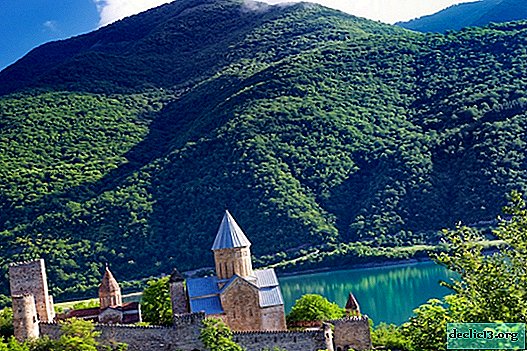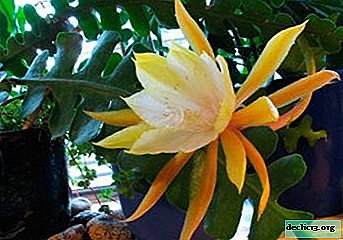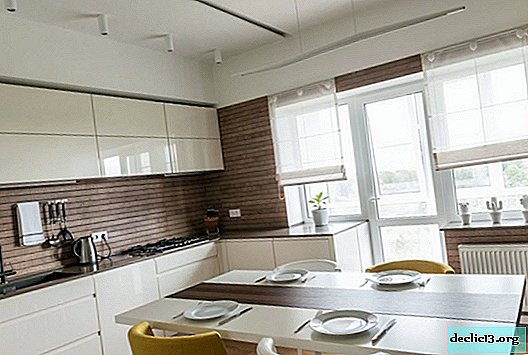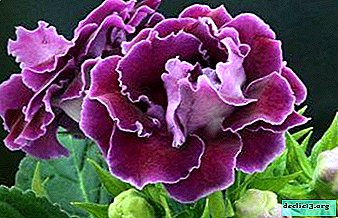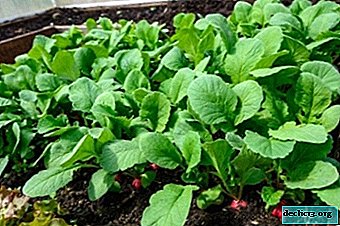Why do Kalanchoe leaves turn yellow and what to do with this and other problems? Plant Care Tips

This beloved by many unpretentious houseplant firmly established on our windowsills.
Kalanchoe, after all, is a rather diverse plant, so everyone easily chooses the suitable option for themselves - a flowering variety or a therapeutic variety.
Of course, this wonderful flower is able to give joy, create comfort and bring real benefits thanks to its healing properties.
What will happen if you do not care for the flower?
Any plant that we grow at home needs good care., he is required, of course, and Kalanchoe. If a plant is ignored or improperly taken care of, then it can immediately have various problems:
- the plant begins to stretch up;
- leaves may turn yellow;
- leaves may fall;
- various harmful insects and diseases may appear.
Read about how to care for Kalanchoe so that it blooms, and from this article you will learn about the intricacies of caring for a flowering plant.
Common diseases and their treatment
If suddenly on your favorite flower the leaves begin to turn yellow or fall off, you need to try to find out the cause of what is happening as soon as possible and urgently take up treatment (about pests and diseases of Kalanchoe, as well as ways to combat them, see here). Let's try to figure out what exactly and exactly how leaf diseases can appear:
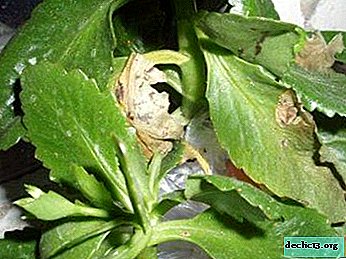 Yellowing. So the plant can signal that it is time to transplant it into a new soil, the soil is depleted, or it lacks fertilizer, you need to transplant the flower into a new pot with a new special soil.
Yellowing. So the plant can signal that it is time to transplant it into a new soil, the soil is depleted, or it lacks fertilizer, you need to transplant the flower into a new pot with a new special soil.- Twisting. The leaves may curl because the root system is damaged, and it was damaged due to improper irrigation, that is, there was a water overflow, the soil was periodically heavily moistened and only a drastic measure would save the situation:
- the plant must be carefully removed from the pot;
- shake off the soil from the roots;
- carefully remove all rotten roots and treat with charcoal;
- allow to dry slightly and plant in a new ground.
- Falling off. The leaves begin to fall in the winter - this means that the temperature regime is incorrectly selected for the plant, the flower most likely is in a stuffy room and somewhere near the battery there is an urgent need to transfer it to a cool room and withstand a temperature of about 15 degrees (this is the ideal temperature for winter) .
- Wither leaves - there can be 2 reasons:
- firstly, the reason may be in the wrong watering: either the plant does not have enough water or, on the contrary, it is too much, it is worth adjusting the watering and everything will work out;
- secondly, the plant may simply have exhausted all of its resources, that is, a natural aging process takes place, in which case it is best to rejuvenate and plant a new bush.
- Spots appear. Black spots may appear on Kalanchoe - this indicates the presence of a fungal disease (again, possibly due to excess moisture). An urgent need to transplant a flower, while changing the soil to looser and adjust the watering (in winter you need to water more than once every two weeks, and in the summer once a week).
The appearance of brown spots on the leaves can be caused by temperature differences and overflow, in this case, the first thing to do is to enter the correct watering regime and avoid drafts - Kalanchoe does not like them.
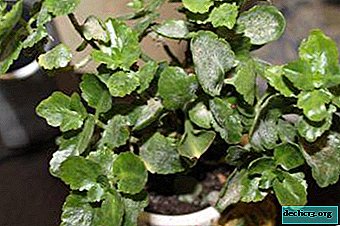 A white coating appears. Due to hard watering, streaks of salt and lime impurities appear on the leaves. The plant can only be watered with soft water, filtered or settled.
A white coating appears. Due to hard watering, streaks of salt and lime impurities appear on the leaves. The plant can only be watered with soft water, filtered or settled.- Leaves become small. This is due to insufficient lighting. The plant does not have enough sunlight, you can not put the pot on the north window and far from the window. Kalanchoe without enough light can die completely, and the leaves can still be smaller due to lack of fertilizing. From spring to late autumn, you need to feed the plant once every two weeks.
Yellowing leaflets
There are several reasons why leaves on the beautiful Kalanchoe suddenly began to turn yellow. It is very important here to correctly diagnose in order to quickly quickly correct the situation. Let's identify the causes and find out how to help the plant:
- The plant was originally planted incorrectly. Could plant in a disproportionate pot, should:
- take a suitable pot size;
- pour on the bottom drainage layer of expanded clay (you can fill them with the third part of the pot);
- plant the plant, carefully spreading the pots;
- to fill up with soil from above.
- Incorrect soil selected. The soil is suitable only for succulents (it must be loose), it will have to be transplanted and preferably faster.
- A pot of plants is in a dark place. This is completely unacceptable, we rearrange the flower on the window, and on gloomy autumn and winter days we light up the phytolamp to eliminate the lack of light.
- Temperature condition is violated. Most often this happens in winter. It can be difficult to create a temperature of 15 degrees for Kalanchoe in the presence of central heating. In this case, you can try to place the plant on a loggia or a veranda or put closer to the glass on the window.
- Watering is in violation. Do not violate the watering regime. Overflow is very harmful and strong “drought” is also harmful - forgetfulness to water on time. The root system can completely dry out and the flower will simply die. An urgent need to adjust the timing of irrigation.
- Lack of fertilizer (or excess). Here the main rule works: do no harm! Excess fertilizing can even affect the plant worse than their lack.
It should be remembered that in winter you do not need to add anything to the soil, and you can fertilize once a month between spring and late autumn.
- The presence of harmful insects. It is necessary to carefully examine the entire bush, if you notice traces of the activity of some pests, you need to urgently treat it with an insecticide.
After the diagnosis and the reasons for the appearance of yellowness on the leaves, you need to take up the elimination of these very causes as soon as possible and return the flower to normal life.
Now you know what to do if the leaves turn yellow at the flower.
Preventative measures
The main preventive measure against any disease is, of course, proper care., which includes the following rules:
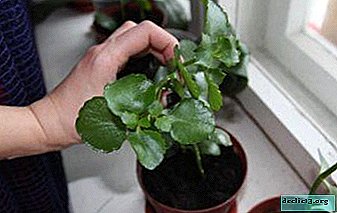 When you bring a new plant from the store home, you need to wait about 2 weeks, then we must transplant the Kalanchoe into a new pot and the corresponding soil, that is, the soil for succulents, do not forget about drainage. The pot should not be very large, the volume should be approximately 2 cm larger than the root system.
When you bring a new plant from the store home, you need to wait about 2 weeks, then we must transplant the Kalanchoe into a new pot and the corresponding soil, that is, the soil for succulents, do not forget about drainage. The pot should not be very large, the volume should be approximately 2 cm larger than the root system.- Kalanchoe loves sunlight very much, therefore it is best for him to determine a place on the east or west window, there will be enough sun, but after three in the afternoon it will need to be shaded a bit (the flower can also suffer from excess light) with a curtain.
- It is necessary to maintain the correct temperature - in winter you need coolness, it is better to keep the flower in a cool room (up to 15 degrees), and in summer the temperature will be 26 - 28 degrees, it is necessary to ventilate the room, but so that the flower is not in a draft.
- Clearly define a watering schedule for yourself, given that in winter you need rare watering, and in summer it is more frequent and plentiful.
It is not necessary to spray Kalanchoe, to water only with settled soft water.
- Do not forget about the necessary fertilizers (for succulents), apply the entire vegetative season in small doses, you can not apply in the winter.
- It is very important not to forget about the formation of the plant, that is, regularly need to pinch and trim Kalanchoe so that it does not stretch, but develop correctly.
- Inspect regularly for various pests.
Conclusion
All living things on earth love caring and care, and Kalanchoe is no exception. If you already have this wonderful plant at home, try not to forget to take care of it. After all, it is completely non-capricious, just its birthplace - the tropics and conditions need to be created to be suitable. And thanks Kalanchoe will try his magnificent flowering or medicinal juice (medicinal varieties).

 Yellowing. So the plant can signal that it is time to transplant it into a new soil, the soil is depleted, or it lacks fertilizer, you need to transplant the flower into a new pot with a new special soil.
Yellowing. So the plant can signal that it is time to transplant it into a new soil, the soil is depleted, or it lacks fertilizer, you need to transplant the flower into a new pot with a new special soil. A white coating appears. Due to hard watering, streaks of salt and lime impurities appear on the leaves. The plant can only be watered with soft water, filtered or settled.
A white coating appears. Due to hard watering, streaks of salt and lime impurities appear on the leaves. The plant can only be watered with soft water, filtered or settled. When you bring a new plant from the store home, you need to wait about 2 weeks, then we must transplant the Kalanchoe into a new pot and the corresponding soil, that is, the soil for succulents, do not forget about drainage. The pot should not be very large, the volume should be approximately 2 cm larger than the root system.
When you bring a new plant from the store home, you need to wait about 2 weeks, then we must transplant the Kalanchoe into a new pot and the corresponding soil, that is, the soil for succulents, do not forget about drainage. The pot should not be very large, the volume should be approximately 2 cm larger than the root system.

